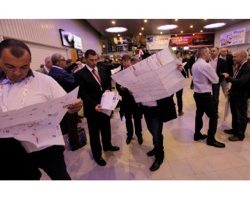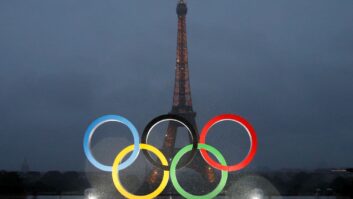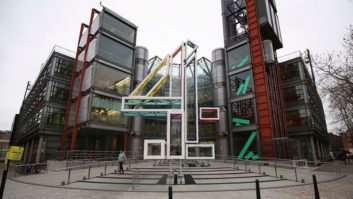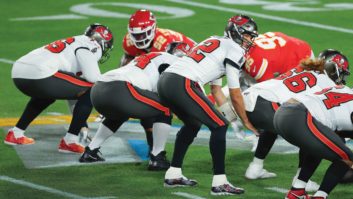
Over the past eight years Russia Today (RT) has seen a massive increase in its audience reach. Starting with just one channel in 2005, the broadcaster now operates three international news outlets, a documentary channel, has significant presence on YouTube and provides a video news agency service. In 2010, RT became the first Russian TV channel nominated for the International Emmy Award in the news category.
“Our total audience reach is around 630 million in more than 100 countries,” explains Andrey Bukashkin, (pictured), chief director of the broadcaster. “We now operate our news channels in English, Arabic and Spanish languages.”
In order to allow for ongoing growth, RT has just completed a move into a new 28,000sqm facility on the eastern side of Moscow. This new venue houses six studios, ranging in size from a virtual reality facility of 141 sqms to the Arabic language studio and newsroom of around 500 sqms. The complex, comprising three buildings, can accommodate a staff of more than 2,000.
“We needed to relocate for two reasons. First, our original building didn’t provide the space we needed to fulfil our expansion programme. We want to be ready to add further channels, including in other broadcast languages, if asked to do so. And secondly, we needed to upgrade our output – especially to become fully high definition — to meet the requirements of the transmission packages we are using. By offering HD we can work with a great many more cable companies and increase our audience further,” states Bukashkin.
He goes on to say that one of the biggest challenges for the move was the sheer size of the undertaking. “We had to purchase new equipment in almost every area because the original complex needed to stay on air until we made the switch. Additionally, our staff needed to maintain transmissions, while still spending time at the new facility to ensure that the installation work was being carried out as we had determined. So, manpower was a definite challenge.”
To meet such a big undertaking, it was obvious that the systems integrator chosen for the project would need to be both well briefed and have the resources in all areas of the production, engineering and transmission chains. “We drew up a very detailed list of specifications for the new building. Our staff put forward ideas about what equipment would be required and the kind of money that we expected to spend. This brief ran to over 200 pages.”
The brief, along with around 40 specific questions about how the project would be handled and how many engineers would be provided, was sent to a number of SIs in Russia, plus one from Finland. “The ongoing support from the SI was very important to us,” emphasises Bukashkin.
The SIs were then invited to provide presentations at which not only broadcast and IT engineers, but also finance experts from RT and building construction personnel were present. “These building experts had a lot more questions than we had placed in our original technical questionnaire.” Bukashkin continues, “After all those presentations we came to an objective decision that OKNO-TV could provide the service and support that we needed.”
Experienced integrator
Formed 22 years ago in Moscow, OKNO-TV is now regarded as the leading company in its field in Russia. Its Moscow business runs from two buildings in the Russian capital, while there are additional offices in St. Petersburg and Siberia. But its operations now spread beyond the borders of Russia, and to help with that expansion programme, a new office has recently been established in London. This new facility, which is rapidly expanding its capability, is tasked with taking the OKNO-TV brand to the global marketplace.
Overseeing the RT project for OKNO-TV was Mikhail Kalanchekaev, the company’s deputy technical director. “Although Russia Today provided some very detailed instructions about the equipment it wanted to use in the new facility, we were able to come up with some suggestions about alternatives. For example, we discussed the choice of routers a great deal.
“From our point of view, routers in such a big environment should be chosen for monitoring capabilities, unified control system requirements, and overall maintenance efforts. In addition, we discussed different possibilities and persuaded the RT team to go with Hitachi Data systems Virtual Storage Platform because of high reliability and good local service.”
In most cases, the choice of equipment has been the same across all studios. For example, Grass Valley Kayenne XL 4ME switchers are seen in all six galleries. “In conjunction with those switchers, we use K2 Solo servers which can store up to 25 hours of HD material,” explains Denis Sevostyanov, RT’s head of Directors’ Service Department. “These servers provide the source for video clips for studio backgrounds, graphic design with sound accompaniment.”
To meet the audio needs, Lawo has provided six mc66MKII studio mixers, three Crystal consoles and a Nova73HD routing system. This central Nova73HD routing matrix allows I/O resource sharing including access rights management.
Each of the three main news studios is equipped with five Ikegami cameras — four pedestal and one crane mounted. There is also a Steadicam available, as needed. Shotoku supplied TRP-100 fully robotic pedestals linked with the TR-8T control system that are used in the English language studio. “The operator sits in the studio and controls not only pan, tilt, focus and zoom, but also the movement of the pedestals,” explains Sevostyanov. “Stored shots are selected using either a mouse or the touchscreen.” Four TP-80VR manual VR tracking pedestal systems are also on order for use in the Virtual Reality studio.
RT’s new facility is located next to a multi-track railway line and it was feared that vibration might cause the robotic system to be affected. However, a special cushioning material was laid under the studio floor and this has proved totally reliable. “We used multi-layered coverage with elastic underneath and an additional cover over the surface,” states Kalanchekaev. Sevostyanov adds, “By using a special anti-vibrating material, we were able to construct the studios so that the floor and the ceiling were not fixed directly to the building structure.”
Graphics throughout the production cycle are executed through Vizrt units. News editing is carried out using Adobe Premiere. In many cases, the news journalists will cut their own material at their desks for final transmission, although editors are available, if required.
Outside of news, there are 25 Avid edit suites in use for programme making. Eight voice-over booths and four Pro Tools digital audio work stations are situated on the same floor and can be connected to any of the editing facilities.
Connecting the areas
In the Master Control Room, RT uses Harris ADC 1000 automation for playout and switching. This comprises two mirrored systems, each of which has a File Server and List Redundancy and controls VTRs, router, VizEngine and a logo inserter. It also controls four Harmonic videoservers — Spectrum MediaCenter (server controller with Integrated storage), Spectrum MediaDirector (server controller), Spectrum MediaPort 7000 (realtime video encoder/decoder), Spectrum MediaStore (storage arrays) and ProMedia Carbon (file-based transcoder).
Communication between the areas of the operation are handled by Riedel units. In all, 37 MediorNet Compact frames are deployed around the studios, MCR, and other operational areas. In addition, there are eight Artist 128 frames and one Artist 64 frame used for the technical communication throughout the whole complex.
Other Riedel equipment includes more than 200 intercom panels – both rack mounted and desktop — comprising a mixture of 2000, 2100, 5100 series and eight CCP-1116 commentary control units. “The complexity of the switching requirements for the various channels meant that we installed three Evertz EQX-576×576 routers to connect MediorNet, audio consoles and wall boxes,” explains Kalanchekaev. “All of these communication devices are running under the Virtual System Management at RT.”
Obviously, this has been a huge undertaking for all concerned, but Kalanchekaev is more than pleased with what has been achieved. “This is the biggest project taken on by OKNO-TV and we worked hard to make RT happy with its new home. We will continue supporting further growth of the facility with the best and most efficient technology available on the market.”
As Bukashkin mentioned earlier, one of the reasons for the relocation was preparation for expansion. So, what is he prepared to discuss? “There are new markets to conquer. And our new facility and our choice of equipment mean that we have the capacity to add another channel in another language in a very short period of time. There are new graphic designs that we want to use. There are definitely far more interactive presentations that can be made. All I can say is that we have lots and lots of ideas for the future.”
By Philip Stevens
www.adobe.com
www.dalet.com
www.evertz.com
www.grassvalley.com
www.harmonicinc.com
www.harrisbroadcast.com
www.hds.com
www.ikegami.com
www.lawo.de
www.okno-tv.ru
www.riedel.net
www.rttv.com
www.shotoku.co.jp
www.sony.co.uk
www.vizrt.com







